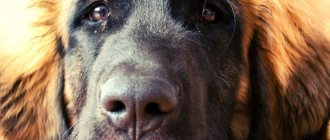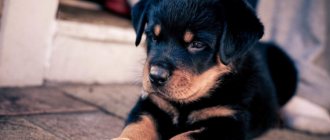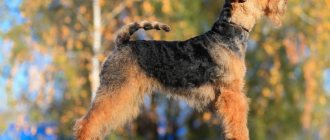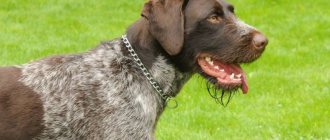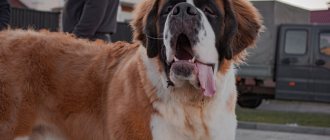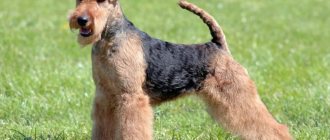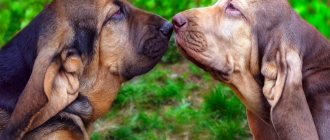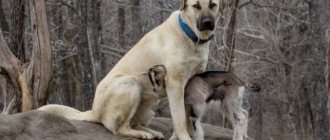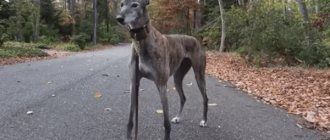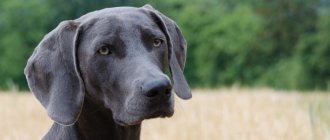The Leonberger dog breed is a large service dog. They are hardy and have an increased protective factor. In the photo of a Leonberger dog you can see its menacing appearance. However, for his owners he is able to become a loyal and loving companion. Most often, this type of dog is used as a rescue dog.
In Germany, where this breed was bred, Leonbergers are used for water rescue.
brief information
- Country of origin: Germany, Baden-Württemberg, city of Leonberg.
- FCI class: group 2 (Pinchers, Schnauzers, Molossians, Swiss Cattle Dogs, etc.). Standard No. 145 dated September 20, 2002
- Purpose: guard dog, family dog, companion.
- Main color: all shades of red with a mandatory black mask.
- Life expectancy: 9-12 years.
- Average weight: from 40 to 75 kg, males are larger than females.
- Height: males from 70 to 85 cm, females from 65 to 80 cm.
- Cost: from 30,000 to 70,000 rubles.
Photo: pexels.com
External data
In the description of the Leonberger breed, it should be added that this breed will have a predominance of rather dense cover, and the color is brownish-yellow.
A fairly common and also distinctive feature here is a black mask on the face and a very voluminous mane on the head.
In this combination, a dog with just one look can instill so much fear, although in fact it is not aggressive.
History of the origin of the breed
In the first half of the 19th century, a member of the city council of the small town of Leonberg, Heinrich Essig, became concerned with creating a breed of dog that resembled a lion. His goal is to combine in the breed his love for animals and his hometown, on the coat of arms of which was the king of beasts. The basis was taken: a Newfoundland female and a St. Bernard male. Next, the Pyrenees Mountain Dog was used in the selection. The result is huge fluffy dogs with white and gray fur.
But the official’s goal was to create an animal that would resemble a lion in its appearance and dimensions. Selection continued, and the first red representatives of the breed appeared in 1846.
The majestic dogs were loved by representatives of the local nobility; they were used by farmers for protection and as draft power. Little Leonbergers were distributed around the world as gifts, winning people's hearts with their kindness and lack of aggression.
During the world wars, the breed experienced difficult times, almost approaching extinction. In the modern world, Leonbergers are known mainly to professionals and amateurs of the breed.
Photo: wikimedia.org
History of the appearance of the species
The Lunberger is actually considered one of the pure and old breeds. The breed itself first appeared in Germany, but cynologists continue to argue about the exact origin of the dogs, but nevertheless, its official version is documented.
According to this version, such breeds were bred by the mayor of a city called Leonberg, and this happened approximately in the 30s. Literally translated from German, the breed can be translated as “mountain lion.”
Mayor Essig loved dogs very much and wanted to get a breed that would be both an adorable guard and look like a lion.
In the photo of the Leonberger dog you can really see the resemblance to a lion - this is its lush mane.
Description of the breed
The Leonberger is a very large, muscular, but elegant dog. Giants are distinguished by their proportional build, absolute self-confidence, and a calm but not apathetic temperament. Surprisingly, huge males are calm towards other animals, rarely show aggression and get along well with children.
Standard
- proportions: it is important that the ratio of the height at the withers to the length of the body is 9:10, and the depth of the chest is about 50% of the height at the withers;
- head: the length of the muzzle and skull should be almost the same; the skin should fit snugly, without forming folds or sagging;
- skull: slightly convex, powerful, but not heavy;
- nose lobe: black;
- lips: fit tightly, black, corners do not droop;
- jaws: developed, scissor bite, but a straight one is acceptable”;
- teeth: set – 42 teeth, absence of M3 is acceptable;
- eyes: shape – oval, size – medium, color – shades of brown (preferably dark). the eyelids are tightly fitted, without visible conjunctiva. The whites should not be red;
- ears: high set, without moving back. Hanging, with a tight fit to the head. Size – medium, fleshy;
- neck: smooth connection with the withers. Long, has no dewlap or dewlap;
- chest: deep, wide, at the elbow level, oval in shape;
- belly: slightly tucked;
- tail: hangs down when standing, curved and raised when moving;
- limbs: very muscular and strong, straight;
- movements: sweeping, equally smooth at all gaits, with a large grip of the front legs and a strong push of the hind legs;
- coat: abundant coat, with thick undercoat;
- color: all shades of red, yellow (lion) with a mandatory black mask.
Rock defects
- cowardice, unmotivated aggression;
- anatomical defects (hunchback, forelimbs that are too turned out, small joint angles, etc.);
- brown nose;
- severe lip depigment;
- lack of teeth (exception – M3);
- undershot, undershot;
- coat and eye color is not within the standard;
- ring tail;
- brown paw pads;
- no black mask;
- a large amount of white fur pigment (on the paws or chest) or in unacceptable places.
View this post on Instagram
Posted by Ivaholes (@ivaholes) Aug 2, 2022 at 1:50 PDT
Muzzle
The breed must have a wide and even muzzle; it will be slightly convex at the edges. Prominent cheekbones. Predominance of black pigment. The lips do not sag in this case. Wide nose and high-set ears
The movements of this breed, despite all its fluffiness, remain quite graceful and completely devoid of clumsiness.
Character and behavioral characteristics
Leonberger is one of the most accommodating, good-natured and reasonable dog breeds. Nature has given the “lion cubs” loyalty to humans; in the family they never fight for authority with the owner. Although Leonbergers are often used as family and territory guards, they do not have such qualities as suspicion of strangers or a sense of “own territory”. Huge size, especially in males, is in itself a warning to attackers. But you shouldn’t think that these dogs are lumps, capable of protecting only as a last resort - prudence and a sober assessment of the situation are constant companions of giants.
Unmotivated aggression is a sign of mental illness, which is rare, since almost all representatives of the breed in our country are pupils of specialized clubs that do not allow individuals with such defects to be bred.
The character trait is long-suffering, somewhat phlegmatic. These traits allow Leonbergers to get along well with children and tolerate loud and energetic games. In reality, all that can threaten a child when interacting with such a giant is physical injury from being run over by a dog during play. Such dogs are not aggressive towards strangers, but are cautious.
They are rather indifferent to other animals. Leons are of little interest in small animals, but if necessary, a rebuff will be given to the provocateur.
The dog's huge size and phlegmatic character suggest that it does not need frequent human contact and can entertain itself on its own. This is wrong. Leons become depressed and stop eating when there is no human contact.
Leonberger character
Representatives of the breed are distinguished by their calmness and equanimity even in those moments when there is chaos and panic around them. A balanced dog has a sweet disposition and is not inherently aggressive. However, his good-natured nature will not prevent him from protecting his master or his family members if necessary.
“People are the most important thing for Leonberg. He feels responsible for his family and tries to keep everything under control, while remaining unobtrusive.
The omnipresent giant is always aware of events. He sincerely loves everyone, and it is impossible not to reciprocate his feelings. Good-natured individuals make excellent companions.
But the change of owner is very difficult for the pet. Stress can change his behavior beyond recognition.
The dog treats strangers quite calmly, without showing excessive negativity or aggression. Therefore, the shaggy pet is good as a guard dog.
He usually chooses a place from which he has a good view of his possessions and is on duty at all times. You can safely entrust Lenberger with both the protection of property and your own safety.
Animals rarely bark. Yes, this is not necessary. After all, the sight of them is usually enough to make the attacker forget why he came.
“A smart dog is able to independently assess the situation and understand whether the use of physical force is necessary.
Representatives of this breed can easily tolerate very loud sounds: thunder, gunshots, firecracker explosions. This ability is innate in them.
Education and training
They are highly trainable, but the process itself has some peculiarities. Dogs are distinguished by their leisurely nature, as if they are considering a command. This can make the owner nervous. It is worth remembering that the necessary qualities in training a Leon are patience and slowness.
There is an opinion: Leonbergers do not need standard training. Dogs are quick-witted and understanding by nature; it is enough to accustom the dog to changing the tonality (higher and lower) of the voice. This will be enough to control it.
Leonbergers are often purchased “in pairs” for better protection. Dog handlers do not advise doing this, since kids can engage in active communication with each other. It is better to take a second pet immediately after the first one has been sufficiently socialized.
OKD is a difficult test for Leons. These big guys will carry out most of the commands with the motto “it’s fine as it is.” Although there are individuals who masterfully complete the OKD course, they participate in agility competitions. Active training should begin at the age of 3-4 months.
Walk
Despite their physically developed body, the “Swabian lion cubs” are not capable of long and exhausting exercises. Dogs do not need long walks, much less heavy exercise.
Do not give your Leonberger puppy long walks, intense jogging or serious physical activity until he is one and a half years old. It is better to change locations more often, show the baby new objects, animals and keep him busy with toys.
Walking an adult - twice a day, for about an hour. This can be a measured walk; in summer it is worth including bodies of water in your route. Leonbergers love water treatments. Swimming is a great workout and a healthy workout for the heart muscle.
You should not bathe the big guy in the evening; the coat should be completely dry before going to bed.
Photo: pxhere.com
Key facts
The Leonberger is a large dog with a graceful gait. A calm and reasonable dog does an excellent job as a watchman. It is also an excellent companion for active people who prefer long walks and jogging in the fresh air.
The pet is well trained, although some disciplines, for example, agility, are not available to him.
The dog is perfect for living in families with small children. The adult will treat them like their puppies.
Leonbergers feel best in country houses, where they have the opportunity to run around the yard. But putting a giant on a chain is strictly contraindicated, since he needs to be in contact with people.
Diseases
Leonbergers are the owners of good health. The main reason is the constant control over breeding by the RKF. In order for a female or male to be allowed to breed, they must have:
- RKF pedigree;
- medical report from a veterinarian for dysplasia;
- test results to assess the exterior, type of animal temperament (kerung).
However, diseases typical of giant dogs have not spared Leons:
- inflammatory bone diseases;
- endocrine diseases;
- bone tissue oncology;
- eye diseases;
- articular dysplasia.
Price of puppies
The price of a Leonberger varies from 30,000 to 50,000 thousand rubles. The breed is not that common.
Therefore, you can’t buy them everywhere. Where to buy a Leonberger dog? They can be purchased from breeders or special nurseries.
Care
Leon's chic fur coat will require basic care. Shedding occurs twice a year and is very intense. Individuals living in a warm room constantly “shed” excess hair throughout the year. Trimming and clipping are not practiced in caring for the breed. The dog needs to be brushed. In an apartment, it is better to do this twice a week or more often, using a wire brush and conditioner to maintain the structure of the coat.
In addition, attention will be required:
- nails: once a month, using a nail clipper for large dogs; special attention is paid to the dewclaws;
- teeth: examination and removal of plaque using special gels and pastes;
- bathing the animal: according to contamination;
- eyes: examination and rinsing with special lotions;
- ears: hygienic cleaning and “airing” - lift the ear and wave it like a fan to ensure a flow of fresh air into the sink.
Food
Leonbergers are considered absolutely not picky when it comes to food. Their digestion is quite slow and therefore they do not eat as much as their size might suggest.
But this dog’s complete diet must include the following products:
- cereals (porridges of various cereals and cereals);
- meat (but you can use low-fat varieties in boiled or even raw form) it should make up about 50% of the daily diet;
- fruits and vegetables (either fresh or boiled in porridge).
Feeding
Surprisingly, with such dimensions, Leonbergers are not gluttons. The reason is slow metabolism. You shouldn’t stuff your dog with food or buy treats to whet your appetite. Excess weight will not be beneficial and will aggravate diseases common to large animals.
If a lion cub demonstrates an unusual zeal for food and rummages through garbage, this is a reason to contact a veterinarian. It is possible that your pet has worms or another disease.
The daily menu should consist of:
- meat products (lean meat and trimmings);
- fish (sea, boneless fillets);
- assorted vegetables with the addition of a tablespoon of vegetable oil;
- cereals (buckwheat, rice), but not more than 20%;
- low fat fermented milk.
When feeding with industrial food, choose from the premium class and higher, labeled “for giant breed dogs.”
Leonbergers should be fed from a stand; when the bowl is low, the animal's stomach stretches.
Nutrition
Proper nutrition is very important for dogs of this breed. It should be balanced and include raw fish, vegetables seasoned with sour cream or vegetable oil, lean meat, cartilage and bones other than chicken.
Leonberger puppy
Under no circumstances should you give sweets or flour products, as obesity is very dangerous for large breed dogs. Also, you should not add hot spices to your food, as this can spoil your sense of smell. In addition, you should not feed various types of legumes due to the peculiarities of the intestinal structure. Another important nuance is maintaining the number of meals.
For puppies 2-4 months old, feeding should be divided into 5-6 times a day. From 4 months to 7 months, the maximum number of meals per day should not exceed 4 times. After 7 months and up to a year, you need to feed the dog 3 times a day. After a year, food is given 2 times a day. In addition, dogs of this breed need a lot of water.
Tips for choosing a puppy
- purchase a baby only from a breed club or from a reputable breeder;
- a healthy Leonberger is cheerful, with a fluffy coat, clear eyes, weighs about 5 kg (at about 45 days);
- eyelid color: there should not be a faded color, this is a sign of anemia;
- at the age of 40-45 days, puppies should lap well from the bowl;
- Enlist informational support from the breeder, at least for the first time.
Photo: pxhere.com
How much does Leonberger cost and where to buy it?
The price of a Leonberger is quite high and does not fall below 30-40 thousand rubles, and the initial cost of a puppy with a good pedigree and a great future is 50 thousand rubles. You can buy a Leonberger in a specialized nursery that breeds this breed.
Under no circumstances should you purchase a puppy from unknown private breeders, since it is not uncommon for dogs with serious deviations from the standard to be sold under the guise of purebred dogs. When choosing a puppy in a kennel, you need to see the Leonberger’s parents in a photo or in person to assess its future.
It is also necessary to check certificates and inspection certificates. After this, get to know your future pets. His reaction should be expressed in interest in communication; if this is not the case, then it is better to refuse to buy this puppy, since problems with his upbringing may arise in the future.
Owner reviews
Alexey O.
We saw the dog for the first time while visiting Stuttgart. The owner of the hotel where we stayed kept a pair of Leonbergers for security. I was very frightened by the size of the dogs. Within two weeks we became friends with them. We were surprised to hear at the end of our stay that they can bark. Something disturbed them at night. The idea of purchasing a security guard for the house stuck in my head. We were never disappointed. Minimal education is needed; it’s as if he learns everything on his own.
Anna K.
Friends brought such a lion cub into their apartment, albeit a three-room one. When the king of beasts grew up, they began to look for somewhere to put him - he took up a lot of space and had a lot of wool. We agreed that we would foster him until a new owner was found. We have our own home.
We still have the dog, but we couldn’t part with him. In the summer he lives on the street, he decided so himself. We are very glad that we left the guy with us. Loves family immensely. He just loves splashing around in puddles and ponds; it’s difficult to wash such a fur coat.
Flaws
There are only three disadvantages in this breed.
The first thing is that training is mandatory; without it, the dog can turn out to be either very lazy or overly aggressive.
The second is its dimensions. Feeding him will be both difficult and expensive.
And the third drawback is that at a young age and until the person has received full training, she cannot be left alone with the child. Since even in the game he can show his strength, although not on purpose.
Photo
Photo: flickr.com
Photo: wikimedia.org
Photo: wikimedia.org
Photo: wikimedia.org
Photo: pxhere.com
Photo: pxhere.com
Photo: pxhere.com
Photo: pixabay.com
Photo: pixabay.com
Photo: pixabay.com
Photo: pexels.com
Possible developmental stigmas
Developmental defects include the following conditions:
- Change in color of paw pads and nose, for example, brown.
- A missing face mask is considered a stigma.
- All visible deformations of the back, limbs, tail (saddle-shaped dips, curvature of limbs).
- Curly wool.
- Large white spots are not standard.
Defects include changes in the number of teeth (with the exception of the 3rd molar) and bite, and lack of pigment in the skin of the lips.
Possible diseases and methods of treating them
In appearance, the Leonberger is a strong and very strong dog, whose body is distinguished by endurance. But, as you know, representatives of large breeds of dogs often encounter joint pathologies. Such animals are diagnosed with dysplasia every year.
If the dog cannot stand up due to severe pain, he will need help from his owners. Doctors prescribe painkillers that are injected into the withers. Why exactly there? There are few nerve endings on this part of the body, so it is insensitive. Do not inject your animal with painkillers unless absolutely necessary!
Some owners who do not know about the rules of feeding dogs overfeed them! The pitiful eyes of a fluffy Leonberger can melt the heart of almost every household member. But the dog must not be allowed to gain weight. His cardiovascular system suffers from this.
Also, do not forget to regularly vaccinate your dog, especially if it often goes outside and interacts with different animals there. Each of them is a source of bacteria and infections that can cause your pet to develop a dangerous disease. And lastly, give your pet anti-worm tablets every summer.
Reproduction and lifespan
Dog breeders know that the best time of year to breed is spring. It is recommended to bring together adult males and females in early April - mid-May. At this time, they are most active in terms of showing sexual interest.
At least 3 days must pass from the start of the female's heat. During this time, her egg will be released into the fallopian tube and fully prepared for fertilization. The male should not show aggression towards the female. If this happens, he is probably not a purebred. Such an individual is not allowed for mating.
The parameters of the parents must fully comply with the accepted breed standard. Otherwise, the breeder will not be able to get a lot of money for the puppies, since people who understand the exterior of rescue dogs will not take them.
68-70 days after mating, the bitch should give birth to puppies. There can be from 1 to 7 dogs in a litter. Unfortunately, the service life of Leonbergers is short, from 8 to 10 years.
